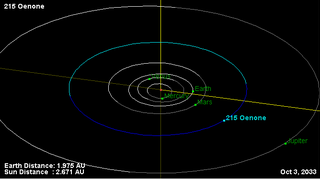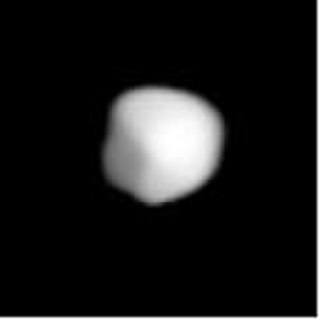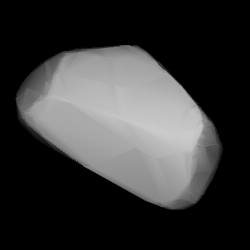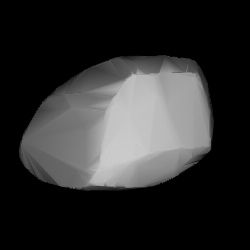
62 Erato is a carbonaceous Themistian asteroid from the outer region of the asteroid belt, approximately 95 kilometers in diameter. Photometric measurements during 2004–2005 showed a rotation period of 9.2213±0.0007 h with an amplitude of 0.116±0.005 in magnitude. It is orbiting the Sun with a period of 5.52 yr, a semimajor axis of 3.122 AU, and eccentricity of 0.178. The orbital plane is inclined by an angle of 2.22° to the plane of the ecliptic.

78 Diana is a large and dark main-belt asteroid. It was discovered by German astronomer Robert Luther on March 15, 1863, and named after Diana, Roman goddess of the hunt. The asteroid is orbiting the Sun at a distance of 2.620 AU with a period of 4.24 years and an eccentricity (ovalness) of 0.207. The orbital plane is tilted at an angle of 8.688° relative to the plane of the ecliptic. Its composition is carbonaceous and primitive.
126 Velleda is a main-belt asteroid. It is probably a rather typical, albeit sizable, S-type asteroid. Named for Veleda, a priestess and prophet of the Germanic tribe of the Bructeri. It was discovered by Paul Henry on November 5, 1872, in Paris, France. It was his first credited discovery. He and his brother Prosper Henry discovered a total of 14 asteroids.

149 Medusa is a bright-coloured, stony main-belt asteroid that was discovered by French astronomer J. Perrotin on September 21, 1875, and named after the Gorgon Medusa, a snake-haired monster in Greek mythology. It is orbiting the Sun at a distance of 2.17 AU with a period of 3.21 years and an eccentricity of 0.065. The orbital plane is tilted slightly at an angle of 0.94° to the plane of the ecliptic.

215 Oenone is a typical main belt asteroid. It was discovered by the Russian astronomer Viktor Knorre on April 7, 1880, in Germany, and was the second of his four asteroid discoveries. The asteroid is named after Oenone, a nymph in Greek mythology.

227 Philosophia is a large main-belt asteroid that was discovered by the French astronomer Paul-Pierre Henry on August 12, 1882, in Paris and named after the topic of philosophy. Based upon photometric observations, it has a synodic rotation period of 52.98 ± 0.01 with a brightness variation of 0.15 ± 0.02 in magnitude.

230 Athamantis is a fairly large main-belt asteroid that was discovered by the German-Austrian astronomer K. de Ball on September 3, 1882, in Bothkamp. It was his only asteroid discovery. The asteroid was named after Athamantis, daughter of Athamas the mythical Greek king of Orchomenus.

239 Adrastea is a main belt asteroid. It was discovered by Johann Palisa on 18 August 1884 in Vienna, and was named after the Greek nymph Adrasteia. This asteroid is orbiting the Sun at a distance of 2.97 AU with a period of 5.11 years and an eccentricity (ovalness) of 0.23. The orbital plane is tilted at an angle of 6.17° to the plane of the ecliptic.

240 Vanadis is a fairly large main-belt asteroid with a diameter of around 100 km. It was discovered by A. Borrelly on August 27, 1884, in Marseilles and was named after Freyja (Vanadis), the Norse fertility goddess. The asteroid is orbiting the Sun at a distance of 2.67 AU with a period of 4.35 yr and an orbital eccentricity of 0.206. The orbital plane is inclined at an angle of 2.10° to the plane of the ecliptic.

248 Lameia is a typical main belt asteroid. It was discovered by Austrian astronomer Johann Palisa on 5 June 1885 in Vienna and was named after the Lamia, a lover of Zeus in Ancient Greek mythology. 248 Lameia is orbiting the Sun with a period of 3.88 years and a low eccentricity (ovalness) of 0.067. The semimajor axis of 2.47 AU is slightly inward from the 3:1 Kirkwood Gap. Its orbital plane is inclined by 4° to the plane of the ecliptic.

300 Geraldina is a large Main belt asteroid. It was discovered by Auguste Charlois on October 3, 1890, in Nice. The origin of the name is unknown. It is orbiting the Sun at a distance of 3.21 AU with a period of 5.74 yr and an eccentricity (ovalness) of 0.057. The orbital plane is tilted at an angle of 0.73° to the plane of the ecliptic.

402 Chloë is a large main-belt asteroid. It was discovered by French astronomer Auguste Charlois on 21 March 1895 from Nice. This asteroid is orbiting the Sun at a distance of 2.56 AU with a period of 4.09 years and an eccentricity of 0.11. The orbital plane is inclined at an angle of 11.8° to the plane of the ecliptic.

413 Edburga is a typical Main belt asteroid. Max Wolf discovered it on 7 January 1896 at Heidelberg Observatory. The origin of the name is unknown. This asteroid is orbiting the Sun at a distance of 2.58 AU with a period of 4.15 yr and an eccentricity of 0.34. Its orbital plane is inclined at an angle of 18.7° to the plane of the ecliptic.

497 Iva is a main-belt asteroid orbiting the Sun, not to be confused with 1627 Ivar. It was discovered by American astronomer R. S. Dugan on 4 November 1902, and was named for Iva Shores, the young daughter of the family where he was staying in Heidelberg. This object is orbiting at a distance of 2.85 AU with a period of 4.82 yr and an eccentricity of 0.3. The orbital plane is inclined at an angle of 4.8° to the plane of the ecliptic.

694 Ekard is a minor planet orbiting the Sun that was discovered by American astronomer Joel Hastings Metcalf on November 7, 1909. The asteroid's name comes from the reverse spelling of Drake University in Des Moines, Iowa, where Seth Barnes Nicholson and his wife calculated its orbit.
718 Erida is a minor planet orbiting the Sun. It was discovered at Vienna on September 29, 1911, by Austrian astronomer Johann Palisa, and was named for Erida Leuschner, daughter of astronomer Armin Otto Leuschner. It is orbiting at a distance of 3.06 AU with a period of 5.34 yr and an eccentricity of 0.20. The orbital plane of this asteroid is inclined by an angle of 6.9° to the plane of the ecliptic.
742 Edisona is a minor planet, specifically an asteroid orbiting in the asteroid belt that was discovered by German astronomer Franz Kaiser on February 23, 1913. It was named for inventor Thomas Edison. This asteroid is orbiting 3.01 AU with a period of 5.22 years and an eccentricity of 0.119. The orbital plane is inclined at an angle of 11.2° to the plane of the ecliptic. This is a member of the dynamic Eos family of asteroids that most likely formed as the result of a collisional breakup of a parent body.
765 Mattiaca is a minor planet, specifically an asteroid orbiting in the asteroid belt. Photometric observations made in 2011–2012 at the Organ Mesa Observatory in Las Cruces, New Mexico produced an irregular light curve and a period of 3.4640 ± 0.0001 hours with a brightness variation of 0.09 ± 0.01 in magnitude. Mattiacum was the Latin name for the city of Wiesbaden, Germany, birthplace of the discoverer.
780 Armenia is a minor planet in the asteroid belt orbiting the Sun. It is named after the Kingdom of Armenia, now Armenia. This object is orbiting at a distance of 3.11 AU with an eccentricity of 0.097 and a period of 5.50 yr. The orbital plane is inclined at an angle of 19.1° to the plane of rotation. This asteroid spans a girth of ~94 km. The long rotation period of this asteroid necessitated light curve data from more than one latitude. The overlapping data provided a solution with a period of 19.891±0.002 h and a brightness amplitude of 0.18±0.03 in magnitude.
880 Herba is a minor planet orbiting the Sun that was discovered by German astronomer Max Wolf on 22 July 1917 in Heidelberg.














